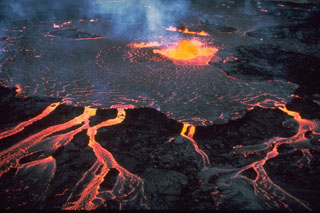Report on Kilauea (United States) — 10 September-16 September 2008
Smithsonian Institution / US Geological Survey
Weekly Volcanic Activity Report, 10 September-16 September 2008
Managing Editor: Sally Sennert.
Please cite this report as:
Global Volcanism Program, 2008. Report on Kilauea (United States) (Sennert, S, ed.). Weekly Volcanic Activity Report, 10 September-16 September 2008. Smithsonian Institution and US Geological Survey.
Kilauea
United States
19.421°N, 155.287°W; summit elev. 1222 m
All times are local (unless otherwise noted)
HVO reported that during 10-16 September, lava flowed SE through a tube system from underneath Kilauea's Thanksgiving Eve Breakout (TEB) and rootless shield complex, reaching the Waikupanaha ocean entry. On 9 September, geologists observed small littoral explosions that ejected debris 20 m into the air. Incandescence flashed from multiple sources within the central and western parts of Pu'u 'O'o crater were seen during 11-12 September.
During the reporting period, Kilauea earthquakes were variously located beneath Halema'uma'u crater, along the S-flank faults, and along the SW rift zones. Beneath Halema'uma'u crater, 50-100 small earthquakes per day (background is 20-40) also occurred but were too small to be located more precisely. The vent in Halema'uma'u crater continued to produce a predominantly white plume with minor ash content that drifted mainly SW. The plume was occasionally tinged brown in association with small local earthquakes. Weak night-time incandescence was intermittently seen at the base of the plume, and rock impact sounds were heard in the vicinity of the crater.
Geological Summary. Kilauea overlaps the E flank of the massive Mauna Loa shield volcano in the island of Hawaii. Eruptions are prominent in Polynesian legends; written documentation since 1820 records frequent summit and flank lava flow eruptions interspersed with periods of long-term lava lake activity at Halemaumau crater in the summit caldera until 1924. The 3 x 5 km caldera was formed in several stages about 1,500 years ago and during the 18th century; eruptions have also originated from the lengthy East and Southwest rift zones, which extend to the ocean in both directions. About 90% of the surface of the basaltic shield volcano is formed of lava flows less than about 1,100 years old; 70% of the surface is younger than 600 years. The long-term eruption from the East rift zone between 1983 and 2018 produced lava flows covering more than 100 km2, destroyed hundreds of houses, and added new coastline.
Source: US Geological Survey Hawaiian Volcano Observatory (HVO)

